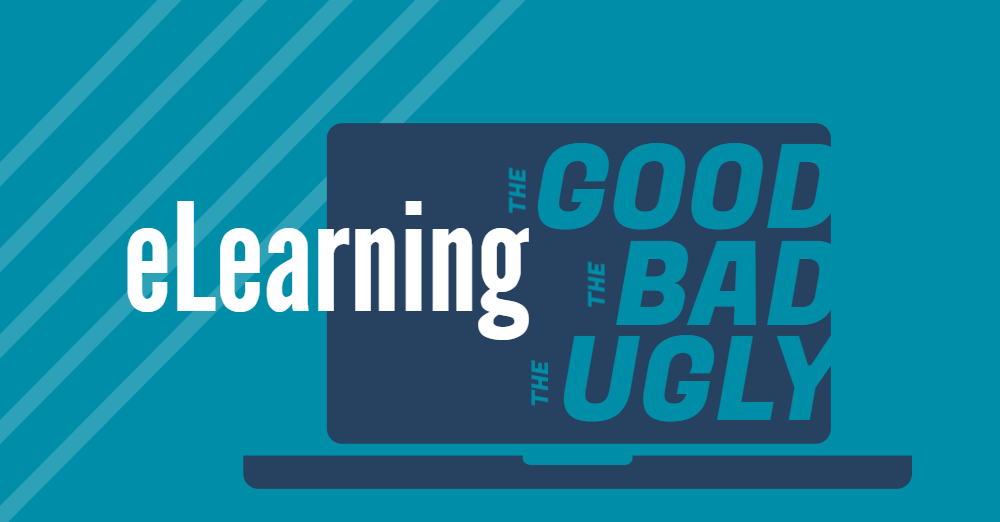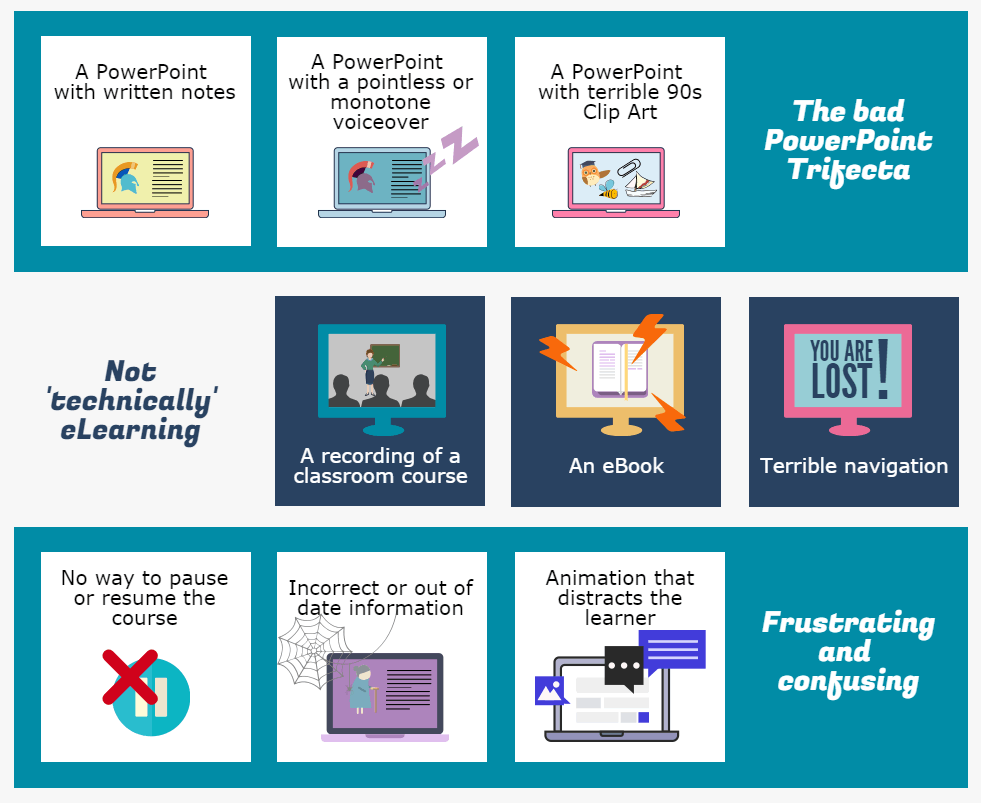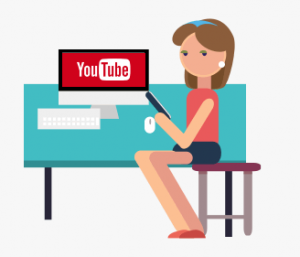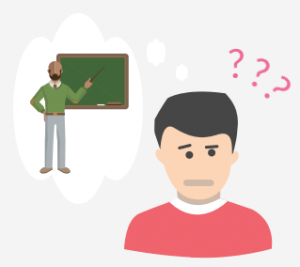- Philippa McIntosh
- April 03rd, 2017
eLearning, in one form or another, has been around for decades. Indeed, one of the first uses of the internet was to connect academics and universities to further the exchange of knowledge. The internet, then, has a long history with education.
So why does eLearning have such a bad reputation compared to traditional classroom training? Especially when the act of listening and making notes has been found to be the least effective way to learn. Surely we should all be desperate to leave classrooms and lectures behind to get on board with eLearning?
The problem stems from how we first started to create eLearning – and how little this process has changed for many. Death by PowerPoint is bad enough in the classroom, but it’s even worse when you only have a screen to stare at. But, while the technology and possibilities have moved on leaps and bounds in the past ten or 20 years, the type of training people are seeing is often unchanged.
As a result, they have the impression that eLearning is dull, lonely and demotivating.
So, let’s put this to bed once and for all by exploring the Good, the Bad and the Ugly of eLearning.
We’ll begin with the Bad.
The Bad
This is where eLearning gets its less than sparkling reputation. And, unfortunately, most of it is down to lack of knowledge or a refusal to invest in updates to training. If organisations purchased a training course for their staff in 2003, they may not understand why they should fork out for a new one. If it ain’t broke, don’t fix it. But unfortunately, it is broken and it’s costing businesses money.
Bad eLearning usually ticks at least one of the following boxes:
The common theme running through bad eLearning is the lack of focus on the learner. It has no structure, no story and is challenging to complete and absorb. Attention has been paid only to the content or to the style, without any consideration for whether providing training in this format will provide the best outcomes for the learner.
If it doesn’t support you to learn the information in a quick, engaging and compelling way then it’s bad eLearning. If you get frustrated by the technology – rather than it simply providing the framework for delivery – then it’s bad eLearning.
So, if that’s bad, what’s ugly?
The Ugly
The ugly side of eLearning comes when companies don’t provide it and leave their people to their own devices.
With the rise of technology, we have all become accustomed to getting things as soon as we want them. We can binge-watch entire TV series, instead of waiting for each weekly episode, and we can order food from our favourite restaurants and have it delivered, hot and on our own kitchen table, within 30 minutes. Technology means we don’t have to wait anymore, which is leading to a rise in impatience.
Against this backdrop, if training is not available when people want it, or they’re told to request it again in a few months, they’ll simply find their own way to get the information they need.
Who hasn’t, at work, Googled something we’re not familiar with? How common is it to watch a YouTube tutorial if you need help with a specific task? Without easily accessible training for your staff they’ll hit the internet and find what they need for themselves.
You might not think this is a problem – after all, it saves you providing the training if they’re willing to get it themselves! However, the problem with this approach is the lack of standardisation. If you’re employees are learning from a number of different sources, they’ll have a number of different interpretations of what they should be doing.
Different ways of doing things leads to different outcomes for your customer, which can lead to variable quality and service. Plus, you’ll encounter a demotivating factor from staff who train themselves, believing their employer doesn’t value them enough to invest in training.
So, you could find that leaving people to train themselves impacts productivity and profitability more than if your staff had undergone no training at all! What we need is a consistent message to drive productivity, improve skills and, ultimately, improve our people and businesses. Searching and learning individually on the net doesn’t provide that.
The Good
Fundamentally, good eLearning is designed and delivered to pass on skills, learning and knowledge in an effective way. After taking any training, the learner should understand the topic, they should retain the information and they should be able to practically apply the lessons they’ve learned.
Following classroom training, learners will typically retain around eight to ten per cent of what they’ve learned. With eLearning, this number soars to between 25 per cent and 60 per cent. The reason for that is simple: Good eLearning continuously engages the learner with interactivity, exercises and animations so they keep being pulled back into the lesson. On top of that, the learner is in control of the pace, so if they feel their attention wandering they can pause and come back to it later.
In the classroom, however, if you zone out or miss something, it may not be covered again and you’ve missed your opportunity to learn it. If you’re distracted or feel the pace is going too fast, you may not have the courage to speak up and ask for a break.
Good eLearning uses interactivity and games to tell a story, and take the learner on a journey. It is not restricted by tradition, and can use any tools available to ensure the lessons are absorbed. However, the interactivity is always purposeful, there is no element added just for the satisfaction of including it.
Effective eLearning must fit with all learning styles. It must include knowledge checks so learners are aware of where their knowledge gaps are, and can address them then and there. It needs to be accessible – in all meanings of the word: Mac and PC compatible, mobile optimised, easy to navigate, start and stop, but also usable by those who may have additional learning requirements.
It’s important to remember that good eLearning is not, and should not be, a substitute for classroom training. There will always be occasions when it is necessary, and preferable, to come together for physical and verbal interactions – not least for relationship building. However, classroom training should no longer be the default.
The benefits of good eLearning are massive:
- eLearning takes 40 to 60 per cent less time to complete than classroom training, and you cover an average of five times more material in an eLearning course.
- In studies, it has been found that 85 percent of the real cost of training is attributed to travel and expenses. With eLearning, this expenditure does not exist.
- You will increase the engagement of staff. 25% of employees who leave a business do so due to lack of training opportunities. Studies have shown that providing training increases staff engagement by 18%.
We’ve barely scratched the surface of eLearning, so if you want to learn more about what you should look for and the red flags to avoid, check out our recent webinar below.
To speak to us about eLearning, or to book a free consultation with one of our eLearning experts, click below.





